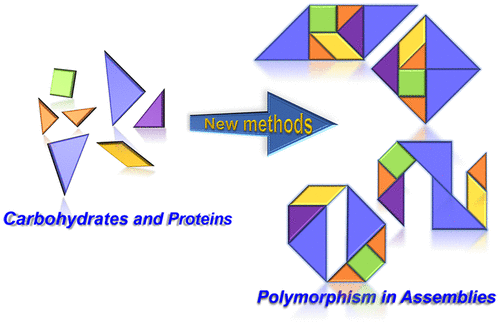当前位置:
X-MOL 学术
›
Acc. Chem. Res.
›
论文详情
Our official English website, www.x-mol.net, welcomes your feedback! (Note: you will need to create a separate account there.)
Exploring and Controlling the Polymorphism in Supramolecular Assemblies of Carbohydrates and Proteins.
Accounts of Chemical Research ( IF 18.3 ) Pub Date : 2020-03-16 , DOI: 10.1021/acs.accounts.9b00552 Chendi Gao 1 , Guosong Chen 1
Accounts of Chemical Research ( IF 18.3 ) Pub Date : 2020-03-16 , DOI: 10.1021/acs.accounts.9b00552 Chendi Gao 1 , Guosong Chen 1
Affiliation

|
ConspectusIn biology, polymorphism is a well-known phenomenon by which a discrete biomacromolecule can adopt multiple specific conformations in response to its environment. This term can be extended to the ability of biomacromolecules to pack into different ordered patterns. Thus, exploration and control of the polymorphism of biomacromolecules via supramolecular methods have been key steps in achieving bioinspired structures, developing bioinspired functional materials, and exploring the mechanisms of these self-assembly processes, which are models for more complex biological systems. This task could be difficult for proteins and carbohydrates due to the complicated multiple noncovalent interactions of these two species which can hardly be manipulated.In this account, dealing with the structural polymorphisms from biomacromolecular assemblies, we will first briefly comment on the problems that carbohydrate/protein assemblies are facing, and then on the basis of our long-term research on carbohydrate self-assemblies, we will summarize the new strategies that we have developed in our laboratory in recent years to explore and control the polymorphism of carbohydrate/protein assemblies.Considering the inherent ability of carbohydrates to recognize lectin, we proposed the "inducing ligand" strategy to assemble natural proteins into various nanostructures with highly ordered packing patterns. The newly developed inducing ligand approach opened a new window for protein assembly where dual noncovalent interactions (i.e., carbohydrate-protein interactions and dimerization of rhodamine) instead of the traditionally used protein-protein interactions direct the assembly pattern of proteins. As a result, various polymorphisms of protein assemblies have been constructed by simply changing the ligand chemical structure and/or the rhodamine dimerization.Another concept that we proposed for glycopolymer self-assembly is DISA (i.e., deprotection-induced glycopolymer self-assembly). It is well known that protection-deprotection chemistry has been employed to construct complex oligosaccharide structures. However, its application in glycopolymer self-assembly has been overlooked. We initiated this new strategy with diblock copolymers. Such copolymers with a carbohydrate block having protected pendent groups exist as single chains in organic media. The self-assembly can be initiated by the deprotection of the pendent groups. The process was nicely controlled by introducing various protective groups with different deprotection rates. Later on, the DISA process has been proven practical in water and even in the cellular environment, which opens a new avenue for the development of polymeric glycomaterials.Finally, the resultant polymeric glyco-materials, as a new type of biomimetic materials, provide a nice platform for investigating the functions of glycocalyx. The glycocalyx-mimicking nanoparticles achieved unprecedent functions which exceed their carbohydrate precursors. Here, the reversion of tumor-associated macrophages induced by glycocalyx-mimicking nanoparticles will be discussed with potential applications in cancer immunotherapy, where such a reversion effect could be combined with other methods (e.g., tumor checkpoint blockade).
中文翻译:

探索和控制碳水化合物和蛋白质的超分子组装中的多态性。
概论在生物学中,多态性是一种众所周知的现象,离散生物大分子可以根据其环境采取多种特定构象。该术语可以扩展为生物大分子包装成不同有序模式的能力。因此,通过超分子方法探索和控制生物大分子的多态性已成为实现生物启发结构,开发生物启发功能材料以及探索这些自组装过程机制的关键步骤,这些过程是更复杂的生物系统的模型。由于这两个物种之间复杂的多重非共价相互作用而难以操纵,因此蛋白质和碳水化合物可能难以完成这项任务。因此,处理生物大分子组装体的结构多态性 我们将首先简要介绍碳水化合物/蛋白质组装面临的问题,然后在我们对碳水化合物自组装的长期研究的基础上,我们将总结近年来在实验室中开发的新策略,以期研究和控制碳水化合物/蛋白质组装体的多态性。考虑到碳水化合物识别凝集素的固有能力,我们提出了“诱导配体”策略,将天然蛋白质组装成具有高度有序堆积模式的各种纳米结构。新开发的诱导配体方法为双重非共价相互作用(即,碳水化合物-蛋白质相互作用和若丹明的二聚化)代替了传统上使用的蛋白质-蛋白质相互作用,指导了蛋白质的组装方式。结果,通过简单地改变配体化学结构和/或若丹明二聚作用就已经构建了蛋白质装配体的各种多态性。我们提出的用于糖聚合物自组装的另一个概念是DISA(即脱保护诱导的糖聚合物自组装)。众所周知,已经采用保护-去保护化学来构建复杂的寡糖结构。然而,其在糖聚合物自组装中的应用已被忽略。我们以二嵌段共聚物开始了这一新策略。带有具有受保护的侧基的碳水化合物嵌段的此类共聚物以单链形式存在于有机介质中。自组装可以通过悬垂基团的脱保护而开始。通过引入具有不同脱保护率的各种保护基,可以很好地控制该过程。后来,DISA工艺在水甚至细胞环境中被证明是可行的,这为高分子糖材料的开发开辟了一条新途径。最后,所得的高分子糖材料作为一种新型的仿生材料,提供了一种新型的仿生材料。一个很好的平台,用于研究糖萼的功能。模仿糖萼的纳米颗粒实现了前所未有的功能,超过了它们的碳水化合物前体。在这里,将讨论模仿糖萼的纳米颗粒诱导的肿瘤相关巨噬细胞的逆转及其在癌症免疫治疗中的潜在应用,
更新日期:2020-04-23
中文翻译:

探索和控制碳水化合物和蛋白质的超分子组装中的多态性。
概论在生物学中,多态性是一种众所周知的现象,离散生物大分子可以根据其环境采取多种特定构象。该术语可以扩展为生物大分子包装成不同有序模式的能力。因此,通过超分子方法探索和控制生物大分子的多态性已成为实现生物启发结构,开发生物启发功能材料以及探索这些自组装过程机制的关键步骤,这些过程是更复杂的生物系统的模型。由于这两个物种之间复杂的多重非共价相互作用而难以操纵,因此蛋白质和碳水化合物可能难以完成这项任务。因此,处理生物大分子组装体的结构多态性 我们将首先简要介绍碳水化合物/蛋白质组装面临的问题,然后在我们对碳水化合物自组装的长期研究的基础上,我们将总结近年来在实验室中开发的新策略,以期研究和控制碳水化合物/蛋白质组装体的多态性。考虑到碳水化合物识别凝集素的固有能力,我们提出了“诱导配体”策略,将天然蛋白质组装成具有高度有序堆积模式的各种纳米结构。新开发的诱导配体方法为双重非共价相互作用(即,碳水化合物-蛋白质相互作用和若丹明的二聚化)代替了传统上使用的蛋白质-蛋白质相互作用,指导了蛋白质的组装方式。结果,通过简单地改变配体化学结构和/或若丹明二聚作用就已经构建了蛋白质装配体的各种多态性。我们提出的用于糖聚合物自组装的另一个概念是DISA(即脱保护诱导的糖聚合物自组装)。众所周知,已经采用保护-去保护化学来构建复杂的寡糖结构。然而,其在糖聚合物自组装中的应用已被忽略。我们以二嵌段共聚物开始了这一新策略。带有具有受保护的侧基的碳水化合物嵌段的此类共聚物以单链形式存在于有机介质中。自组装可以通过悬垂基团的脱保护而开始。通过引入具有不同脱保护率的各种保护基,可以很好地控制该过程。后来,DISA工艺在水甚至细胞环境中被证明是可行的,这为高分子糖材料的开发开辟了一条新途径。最后,所得的高分子糖材料作为一种新型的仿生材料,提供了一种新型的仿生材料。一个很好的平台,用于研究糖萼的功能。模仿糖萼的纳米颗粒实现了前所未有的功能,超过了它们的碳水化合物前体。在这里,将讨论模仿糖萼的纳米颗粒诱导的肿瘤相关巨噬细胞的逆转及其在癌症免疫治疗中的潜在应用,



























 京公网安备 11010802027423号
京公网安备 11010802027423号